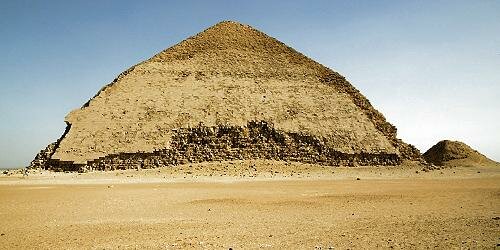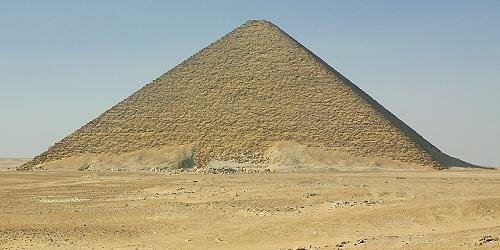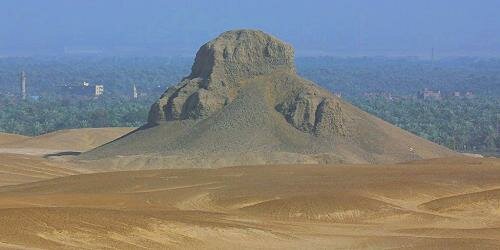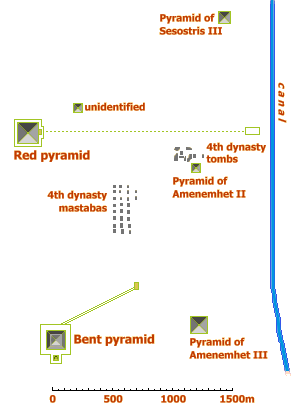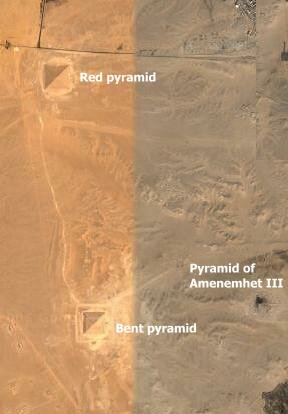|
|
||||||||
|
|
dahshur - ancient cemetery
The Bent Pyramid The Bent Pyramid and the Red Pyramid were constructed during the reign of Pharaoh Snefru of the Old Kingdom, father of Khufu. The unusual shape of the Bent Pyramid is unique, and represents a transitional pyramid form believed to have been necessitated by an engineering crisis encountered during its construction.
It is thought that this was done to alleviate stresses that had become evident in the lower part of the pyramid, either in the foundation blocks or the ground underneath. This resulted in a rhomboid or "bent" silhouette, and makes Snefru's pyramid the most distinct structure at Dahshur. The Bent Pyramid, known as "the southern shining pyramid" is also distinct for another reason: it still has much of its outer casing intact. Rather unusually it has two entrances - the more usual northern side entrance is about twelve metres above the ground, and a second entrance is located on the western side, much higher up. At the centre of the eastern side of the Bent Pyramid is a small offering chapel, composed of two walls of tura limestone roofed with slabs and expanded by mudbrick walls. Just to the south of the pyramid but still on the pyramid axis, stands a small cult pyramid (see above). The entrance, at ground level, is on the north side and leads into a corridor that first descends, then ascends out into a small corbel vaulted room some seven metres high. Many scholars consider this corridor to be the model for the Great Gallery in Khufu's pyramid at Giza. The Red Pyramid Construction began on a second pyramid approximately 2km to the north. This was to become the "Red Pyramid", so named for the red limestone used in its construction, the world's first "true", or smooth-sided pyramid in Egypt and the immediate predecessor of the Great Pyramid. It has a slope angle of 43°, and is second in size only to the Great Pyramid, being just ten metres smaller. When completed, it must have been an incredible sight, for its name translates to "the shining pyramid".
The Red Pyramid has a small offering chapel in the middle of the east side surrounded by a mud brick wall. There would have originally been an enclosure wall surrounding the perimeter, of which some traces still remain. It was rectangular in shape and oriented east-west. A cult/satellite pyramid has yet to be found and may never have existed. Middle Kingdom Pyramids The "white pyramid" of the 12th Dynasty king Amenemhet II is now badly damaged, but next to it were found several undistubed tombs of royal ladies, including two princesses, Khnumet and Ita. The burials contained a great deal of jewellery. The pyramid of Sesostris III was part of a huge complex with several smaller pyramids of royal women and a temple south of the pyramid. In a gallery tomb next to the pyramid were found two treasures of 'king's daughters'. The Black Pyramid dates from the later reign of Amenemhet III, and although in a highly eroded condition is still the most imposing monument at the site after the two Snefru pyramids. The pyramid lies about one kilometre south of Snefru's Bent Pyramid. The fine limestone casing was robbed in antiquity and the darker mudbrick core lies exposed, from whence it's name, The Black Pyramid is derived. The polished granite pyramidion or capstone of the Black Pyramid is on display in the main hall of the Egyptian Museum in Cairo. Next to the pyramid was found the partly disturbed tomb of 13th Dynasty king Hor and next to it the undisturbed burial of his possible daughter Nubhetepti-khered.
In addition to the pyramid complexes, Dahshur also contains a number of minor monuments. There are the companion temples to each pyramid and auxiliary tombs for members of the family and favoured officials. There are also the mastabas of various princesses and queens, which contained many examples of Middle Kingdom jewellery, most of which are now in the Cairo Museum.
|
|||||||
|
||||||||

 Located in a patch of desert on the west bank of the Nile approximately 40 kilometres south of Cairo is the royal necropolis of Dahshur, known chiefly for several pyramids, two of which are amongst the oldest, largest and best preserved in Egypt. Dahshur forms the southernmost area of the Memphis Necropolis and contains several royal pyramid complexes and monuments. Having been categorised as a military zone until 1996, Dahshur was not accessible to the public until this time. As a result, the area is not as developed commercially as Giza, and there is a certain peace and tranquillity to the site still. It is most noteworthy for being the location that best demonstrates the change from the "step" pyramid to the "true" pyramid that occurred during the third and fourth Dynasties.
Located in a patch of desert on the west bank of the Nile approximately 40 kilometres south of Cairo is the royal necropolis of Dahshur, known chiefly for several pyramids, two of which are amongst the oldest, largest and best preserved in Egypt. Dahshur forms the southernmost area of the Memphis Necropolis and contains several royal pyramid complexes and monuments. Having been categorised as a military zone until 1996, Dahshur was not accessible to the public until this time. As a result, the area is not as developed commercially as Giza, and there is a certain peace and tranquillity to the site still. It is most noteworthy for being the location that best demonstrates the change from the "step" pyramid to the "true" pyramid that occurred during the third and fourth Dynasties.